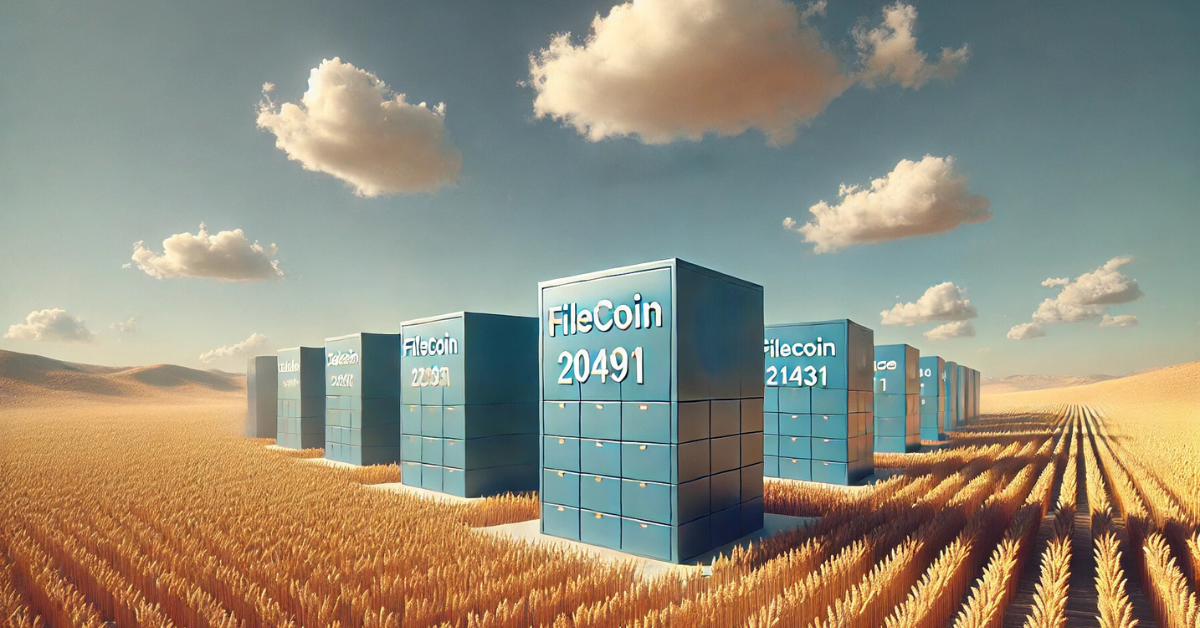Are you tired of paying hefty charges in exchange for storing your data? That ends now. The only way forward is now Decentralized data storage. And Filecoin is here to do just that.
There are only a handful of centralized cloud storage services because of which they demand whatever they desire from the clients. The dominance of cloud services like Amazon, Microsoft and Google has created huge challenges for people who can’t afford to pay a large sum for keeping their data safe.
The founder, Juan Batiz-Benet, saw the monopoly of a few big companies and decided to create a network that would make data storage more affordable, secure and even decentralized. With the help of Protocol Labs he created a system to make it easier for people across the globe to store their data at affordable prices.
In this article we’ll learn everything there is to know about Filecoin and how it has progressed so far over the years. Let’s get started.
What is Filecoin?
Filecoin is basically a decentralized storage network with hundreds of computers that have free space to offer. This ecosystem is transforming how digital information is stored and accessed. Unlike traditional cloud service, Filecoin has created a peer-to-peer network of computers to provide efficient and budget-friendly storage solutions.
As all the other crypto ecosystems, Filecoin also uses Blockchain technology to work its magic and create a flawless decentralized storage network. As Filecoin is a decentralized network, it has numerous benefits over our traditional storage solutions. It significantly reduces the risk of data breaches and censorship as your data is not stored in a single or centralized location.
Apart from this, this network is made as such that the providers have to compete between each other. This way the people or companies providing the storage space offer affordable rates and provide top-notch service so their clients would never choose another party over them.
For those interested in exploring more about other blockchain technologies and tokens, check out our comprehensive guides on:
- Exploring Solana: A Complete Guide to the High-Performance Blockchain
- Earn Crypto Browsing with Basic Attention Token (BAT)
- Stellar Coin: Connecting Economies with Ease
- Chainlink: Decentralized Oracle Network Explained
- MANA Coin: The Currency Powering Decentraland’s Metaverse
- NEAR Protocol: Scalability Through Sharding
The Native Token of Filecoin – $FIL
Like another other crypto project, Filecoin also has a native token that is used for almost everything inside the ecosystem. The native token for Filecoin is $FIL. This token plays a significant role as anyone trying to perform a transaction inside the Filecoin ecosystem needs to have the FIL token.
The few roles of Filecoin’s FIL tokens include:
1. Incentives for Storage Providers
The very first thing for which FIL crypto is used is for incentivizing storage providers. These providers include individuals and organizations who’ve got unused storage which they lend on the Fielcoin network as storage providers. They earn FIL tokens for renting out the free space to people who really need it.
These incentives motivate the participants to provide more space for the network and earn more from it. This way they make the storage spaces as reliable as possible and that too at affordable prices.
2. Payment for Storage and Retrieval Services
Now the people who’re using the Filecoin network to store their data need to pay some fees as well which is obvious. The fees is of two types:
Storage Fees: This fee is paid in form of FIL tokens for the storage providers so they would store your data. This fee depends on the reliability of the storage provider and the competition.
Retrieval Fees: This second fee is applied when the user wants to access the data again and claim it back. This fee is taken to ensure the data access is as smooth and efficient as possible.
3. Economic Security and Stability
The use of FIL crypto creates a competitive marketplace so that the storage providers would provide the best rates. This also improves the overall network efficiency and innovation. These tokens also play an important role in maintaining the security of the network.
The storage providers also have to provide FIL tokens as collateral so they can be compelled to provide the best service or else their token will be taken away.
4. Governance and Development
The people who have Filecoin FIL tokens have the right to vote in matters to network development. This way the holders can provide opinions on important matters that would benefit all the participants.
If you want to learn about a crypto token which allows seamless digital payment with high security, click here: Stellar Coin: Connecting Economies with Ease.
How Does Filecoin Network Work?
The Filecoin network is divided into three key parts:
1. Storage
At first the individuals and organizations that have free space they register in the Filecoin network and provide FIL tokens as collateral for their service. It means they’ll have to invest a few FIL crypto to start providing the service.
Now once they are in the system, clients can choose from the available storage providers based on the price, location and reputation. The data the client sends is divided into small packets of data and sent to the providers in an encrypted form so it cannot be breached on the way.
2. Verification
Now for the verification part the Filecoin network uses cryptographic proof (PrRep and PoSt) to ensure that the storage providers are providing a service that they agreed upon in the beginning.
This proof is publicly verifiable on the Blockchain in the form of blocks. A block is verified if the storage is on point and if not then the block fails.
3. Retrieval
Lastly, the retrieval process is as simple as data storage. All you need to do is pay a fee for the service and get the data back whenever you want. This process is designed in a way so that it’s quick and efficient.
Benefits of Decentralized Storage Solutions
There are multiple benefits of using decentralized storage solutions which include:
- Enhanced Security: Decentralized storage distributes data across multiple nodes. This reduces the risk of data breaches and ensures data integrity.
- User Control: In Decentralized storage solutions you have complete control over your data which is then encrypted. It ensures that only authorized parties can access the stored information.
- Affordability: Decentralized storage also reduces costs by eliminating intermediaries. This is because the network uses unused storage capacity from various providers.
Filecoin Tokenomics
The tokenomics of Filecoin network include:
Baseline Minting
The network has allocated 770 million FIL tokens for the minting process according to how the network will perform in the next few years. However these tokens will completely be in the circulating supply only if the Filecoin network achieves a storage capacity of one Yottabyte within 20 years. This is 1000 times larger than the current global storage capacity.
Simple Minting
According to their docs, a total of 330 million FIL tokens will be distributed over time using a six-year half-life model. This means that 97% of these tokens will be released over the period of approximately 30 years.
Mining Reserve
The company has reserved over 300 million FIL crypto for future mining incentives. This is done so that the network can grow and innovate over the next many years.
Vesting Schedule
Filecoin network introduced the vesting schedule to make sure the whole ecosystem is run for a long time. The 25% of the block rewards are readily available for the storage providers whereas the remaining 75% rewards are vested for a period of 180 days. This is done to ensure that storage providers don’t run away after getting the block rewards in one go.
Apart from storage providers, the FIL tokens were vested for a period of over 6 years to the Protocol Labs team and the Filecoin foundation. For SAFT investors, the vesting period was set to three years.
Collateral and Slashing
To ensure that the storage providers are on their best behavior, they are obligated to lock Filecoin tokens as Collateral during block reward mining. This ensures consensus security, storage reliability and contact guarantees.
This amount varies depending on the block rewards. If the storage providers fail to comply with the standards and don’t pass the reliability checks, their collateral and earned rewards are slashed or in simple words, liquidated or seized.
Total Supply
Filecoin has a maximum circulating supply of 2 Billion FIL tokens. However, it’s unlikely that we would see this token reach this amount of circulating supply. That’s because the tokens are also burnt as gas fees and penalties which reduces the number of FIL tokens from the overall supply.
History of Filecoin
The Filecoin project was launched in 2017 which means it has been over six years since it’s launch. The concept presented by this project was very unique and solved major storage issues for hundreds of thousands of individuals. Because of this it gathered significant attention during the Initial Coin Offering (ICO).
Filecoin raised over $200 Million just within the first 30 minutes of its ICO. The project has also made some important contributions in the past few years. In April 2021, the Filecoin foundation donated 50,000 Filecoin FIL tokens which were valued at $10 million at that time to the Internet Archive.
Notable Milestones
Since its launch Filecoin has had many major upgrades and milestones which it reached. These include:
| Date | Milestone |
| Sept. 25, 2019 | Alphanet release |
| Oct. 16, 2019 | Lotus protocol implementation |
| Dec. 11, 2019 | Testnet Phase One release |
| Jan. 31, 2020 | Filecoin implementation in Rust and C++ |
| May 14, 2020 | Testnet Phase Two release |
| Oct. 15, 2020 | Mainnet release |
| Feb. 2, 2021 | Venus protocol implementation on mainnet |
| Aug. 3, 2021 | Released Web3 storage, a simple interface for data storage and retrieval |
| Oct. 13, 2021 | First official storage collaboration with Flow blockchain |
| April 11, 2022 | Public Network Indexer for querying content-addressable data on Filecoin |
| March 14, 2023 | Filecoin Virtual Machine (FVM) mainnet release |
| March 20, 2023 | Celer cBridge and IM support for Filecoin FVM |
| May 25, 2023 | Filecoin Data Tools |
Current Metrics for Filecoin Network
As of July 27, 2024:
- Filecoin has produced ~4.12 million blocks with a network storage capacity of ~22.591 EiB.
- The current circulating supply is 619,166,336 FIL tokens.
- There are 2413 active miners on the network collectively pledging ~153.37 million FIL.
- Miners receive an average block reward of ~7.4398 FIL.
Filecoin Current Network Upgrade
Since its launch, Filecoin has undergone major network upgrades which have made Filecoin better and more efficient. The latest upgrade of Filecoin network was the Watermelon upgrade (V21). It was activated successfully on December 12, 2023.
The main focus of this upgrade was to simplify operations for storage providers and also introduced several improvements to the protocol and the Filecoin Virtual Machine (FVM).
Understanding Storage Deals
As we already know that the main goal of Filecoin is to store the most valuable data. But for storage providers this means they have to accept deals and store deal sectors that contain the real data. These sectors are either 32 or 64GiB in size and must be in the form of CAR files.
Data Preparation
It’s exactly what you think. The data is stored into packaging files known as CAR files. This can either be done with the help or Data preparer or the storage providers can also act as Data Preparers. Usually the storage who are new handle both the tasks as they have relatively fewer files.
Deal Market
Now to accept deals, the storage providers have to download software like Boost. This software interacts with data owners and accepts deals that meet configured requirements. It then obtains the prepared data in CAR files form and processes them through the sealing pipeline. All this is done to meet network standards.
Once storage providers receive the files, they must keep unsealed data copies available for client retrieval requests. The software also handles HTTP retrievals and sets retrieval prices. Providers can also use platforms like Spade as deal-making engines in addition to Boost.
Understanding Verified Deals
The Filecoin network has created a program called Filecoin Plus (FIL+) to encourage the storage of valuable data through verified deals. A deal only becomes verified when the owner of the data completes a verification process assessed by community notaries. This is done to ensure that the data is relevant and has value according to Filecoin’s mission.
DataCap
The DataCap is allocated by Notaries. It is a non-exchangeable asset which is given to clients with valuable storage use cases. DataCap is assigned to a wallet and can only be spent on verified deals with storage providers. The DataCap balance decreased according to the size of the data which the client stores in the verified deals.
Quality Adjusted Power (QAP)
Storage providers are incentivized to store verified deals with a 10x quality adjustment multiplier. Now what does this mean? Let’s see an example.
If you’re storing a 100 TiB dataset, it will account for 1 PiB of QAP. This process increases the storage provider’s share of storage power on the Filecoin network and makes them more likely to win block rewards. This means earning 10x more rewards for the same storage capacity if it is used for verified deals.
Which Wallets are Compatible with Fil Token?
The wallets compatible with FIL token include:
| Wallet Name | Features | CTA |
| Ledger Nano X | Offline private key storage, Bluetooth connectivity, supports multiple cryptocurrencies, user-friendly interface, robust security features. | Learn more and secure your Filecoin with Ledger Nano X |
| Trust Wallet | Supports a wide range of cryptocurrencies, user-friendly interface, integrated decentralized exchange. | Explore Trust Wallet for easy Filecoin management |
| Atomic Wallet | Supports over 1000 cryptocurrencies, encrypted private keys stored on the device, built-in exchange service. | Explore Trust Wallet for easy Filecoin management |
| MetaMask | Popular Ethereum wallet configured to store Filecoin, integrates seamlessly with web browsers. | Install MetaMask to manage your Filecoin in-browser |
| Glif Web Wallet | Supports sending and receiving FIL, integrates with Ledger hardware devices for added security. | Use Glif Web Wallet for secure Filecoin transactions |
Filecoin FIL Crypto 2024 Priorities
The Filecoin network has highlighted three main points on which they have already been working on for the last few months. They have made significant changes and are still on the go to create a better ecosystem. These three priorities include:
1. Integrating DePIN, Compute, Storage, and AI Networks
The main aim for this year is to bring various networks like DePIN (Decentralized Physical Infrastructure), compute, storage, and AI onto its platform through Layer 2 (L2) solutions. The major developments in this include:
- Fluence launched as the first Filecoin compute L2 in March.
- Basin plans to be the first data L2, helping onboard DePIN, compute, and AI networks.
- Other L2 projects in the pipeline include Storacha, Akave, Lilypad, and CoopHive.
The F3 fast finality system will enhance cross-chain interoperability which would allow other networks to use Filecoin storage in real-time. This system is expected to have a soft launch in Q3 and we can see it in full activation by October/November.
2. Becoming the Core Storage Layer for Web3
Since its launch Filecoin has wanted to become the biggest and the main storage solution for the Web3 ecosystem. A few notable integrations in this regard include:
- Solana announced its integration with Filecoin storage in Q1.
- Many Web3 networks are turning to Filecoin for decentralized storage through platforms like Basin, Akave, web3.storage, and Lighthouse.
By using F3 it will enable EVM-compatible networks to integrate programmable storage and backup using Filecoin. After this these networks can pay in their own ERC20 tokens which are then converted to FIL tokens for long-term storage.
3. Enhancing Filecoin for Hot Data and Fast Retrievals
Filecoin has been working on improving the data retrieval speed and support for valuable data. Some notable achievements in this include:
- The Spark retrieval checker has helped top storage providers achieve over 90% retrieval success rates.
- L2 data onramps like Basin, Akave, and Storacha are focusing on hot, fast storage solutions, targeting Q3 testnets.
They are in process of creating a new proof type called Proof of Data Possession (PDP). It will enable lightweight data accessibility without the need for sealing and unsealing sectors. By doing so the new storage providers will be able to offer fast retrieval times.
Filecoin vs Traditional Storage Services
The difference between Filecoin and the traditional storages services is:
| Filecoin | Traditional Storage Services |
| Decentralized network with multiple storage nodes | Centralized data centers controlled by single entities |
| Enhanced security through encryption and distributed storage | Varies, with strong security but central points of failure |
| Users retain control over their data | Providers control data management and storage practices |
| High privacy with zero-knowledge proofs and encryption | Varies, often involves trust in the provider’s policies |
| Data redundancy across multiple nodes | Redundancy within centralized data centers |
| Improving with Layer 2 solutions and Proof of Data Possession | Typically high-speed access |
| Pay-as-you-go with FIL tokens | Subscription-based or pay-as-you-go with fiat currency |
| Supports cross-chain interactions and integrations | Limited to provider-specific ecosystems |
Conclusion: The Future of Filecoin and Decentralized Storage Solutions
Currently the cloud storage market is dominated by giants like AWS, Google Cloud and Microsoft Azure. But these services are continuously facing issues like privacy concerns, outages, and high costs.
To tackle these challenges the Decentralized storage solutions are on the rise. And Filecoin being the first to introduce this concept is on top of all the others. The Filecoin network is currently focused on few areas which include:
- Data Indexing and Delivery: Improving how data is organized and retrieved.
- Payment Models: Developing efficient and scalable payment mechanisms for storage services.
- Privacy-Preserving Data Processing: Utilizing zero-knowledge proofs to ensure user privacy while processing data.
- Layer-2 Scaling Solutions: Enhancing the scalability of the network to handle more transactions and data efficiently.
Frequently Asked Questions
How to buy FIL crypto?
If you want to buy FIL crypto you need to go to a cryptocurrency exchange on which the token is listed. You can create an account if you don’t have one already. Visit Binance, Coinbase, or Kraken if you want to buy FIL. Search for FIL inside the exchange interface, add the amount you want to buy and complete the purchase.
Can businesses use Filecoin for enterprise-level storage needs?
Yes, businesses can use Filecoin for enterprise-level storage. There’s no restriction to who can and cannot use the storage solution by Filecoin. Its decentralized network offers scalable, secure, and cost-effective storage solutions which is also suitable for large-scale data management and retrieval needs.
Is Filecoin storage cheaper than centralized cloud services?
Yes, Filecoin storage is often cheaper than centralized cloud services. The Filecoin network contains various miners offering different prices. This diversity combined with low entry barriers and a permissionless model makes the entire ecosystem more efficient and cost-effective.
How do Filecoin’s storage providers benefit from the network’s design?
Storage providers benefit from decentralized data storage by earning FIL tokens for storing and retrieving data. The network’s design also allows them to use automated tools and protocols to manage storage in an efficient and secure manner.
How does Filecoin integrate with other blockchain networks?
Filecoin uses interoperability protocols like the Filecoin Virtual Machine (FVM) and Interplanetary Consensus (IPC). The network uses both of these protocols to integrate with other blockchain networks.






